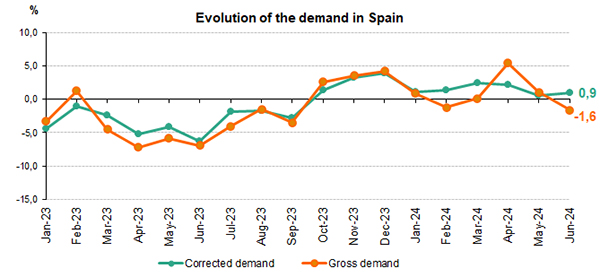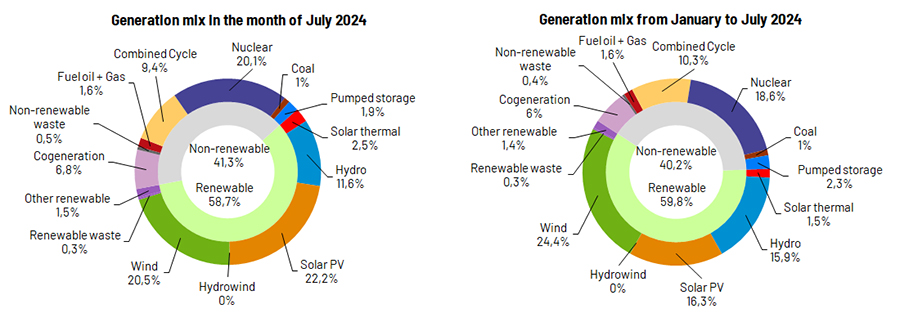For 40 years, we've been driving our country's economic and social progress. Four decades shaping Spain.
Spain's Electricity Demand Increased by 0.9% in June
- For the second consecutive month, solar photovoltaic leads the national generation mix with 22.2% of the total
- Renewable energy production in our country accounted for 58.7%, while technologies that do not emit CO2 equivalent reached a share of 80.3%

National electricity demand in June experienced a 0.9% increase compared to the same month of the previous year, once the effects of temperature and working patterns were factored in. In gross terms, demand is estimated at 19,525 GWh, 1.6% lower than in June 2023.

In the first six months of 2024, Spain registered a demand of 120,892 GWh, 0.7% higher than in the same period of 2023.
This month, renewable energy generated 12,665 GWh, 29% more than in June 2023, accounting for 58.7% of the total. This marks the second consecutive month that solar PV leads the national mix, with 22.2% of the total. This technology produced 4,791 GWh, a 23.8% increase compared to June 2023.
Notably, on June 21, solar PV set a record for daily production with 201 GWh, representing 26.8% of the total.
According to the provisional data currently available, wind was the second-highest electricity-producing technology in June, with 20.5% of the total, followed by nuclear (20.1%) and hydro (11.6%).
With this boost from renewables, 80.3% of the electricity produced in Spain in June 2024 was free of CO2 equivalent emissions.

Peninsular demand increases by 1%
On the mainland, once the effects of working patterns and temperature were factored in, demand was 1% higher than in June 2023. In gross terms, this month's demand was 18,252 GWh, 1.6% lower than the same month of the previous year.
In the first half of the year, peninsular demand was 113,710 GWh, 0.6% higher than in 2023.
Peninsular renewables generated 60.7% of the total in June, according to the provisional data currently available, which show a production of 12,424 GWh, 28.5% more than in the same month of the previous year. CO2-free technologies contributed 83.6% of the total.
The mainland generation structure in June was also led by solar PV, responsible for 23% of the total by producing 4,703 GWh this month, 23.7% more than in June 2023.
Electricity systems in the Balearic and Canary Islands
In the Balearic Islands, electricity demand in June was 0.2% lower than in the same month of 2023, once the effects of working patterns and temperatures were factored in. Gross demand is estimated at 535,998 MWh, 2% less than in June of the previous year. From January to June 2024, gross demand in the Balearic Islands is estimated at 2,721,988 MWh, 0.4% higher than in the same period of 2023.
The combined cycle accounted for 57% of the energy produced in the Balearic Islands, which constitutes the island’s main source this month. Renewable energy generation without CO2 equivalent emissions in the Balearic community represented 18.2% of the total. Balearic renewable production grew by 33.9% in June compared to the same month of the previous year.
Additionally, the submarine link between the mainland and Majorca contributed 27.2% of the Balearic electricity demand this month.
On the other hand, electricity demand in the Canary Islands decreased by 0.4% compared to the same month in 2023, considering the effects of working patterns and temperatures. Gross demand was 704,176 MWh, 1.3% less. In the first six months of 2024, Canary Islands demand is estimated at 4,273,647 MWh, 2.4% higher than in the same period of 2023.
The combined cycle, with 40.2% of the total, was the primary source of electricity generation in the Canary Islands in June. Renewables and emission-free technologies reached a share of 24.2% of the production, with wind contributing 18.9%. Renewable production in the Canary Islands in June grew by 75.5% compared to the same month in 2023.
Visit our daily assessment report for more information on the national, peninsular, Balearic, and Canary systems as of the end of June.
Downloads












